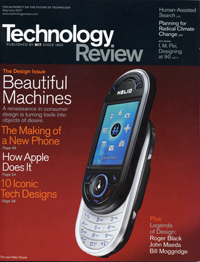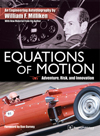|
Equations of Motion -
Adventure, Risk and Innovation
Price: $39.95
|

Technology Review - May/June 2007
A Thrilling Life - Recollections of a speed demon
Review from Technology Review, May/June 2007
In Watkins Glen, NY, a road-racing mecca and longtime host of its own Grand Prix, there is a street corner named after Bill Milliken "34. There, in 1948, during the country"s first postWorld War II road race, Milliken took a turn too fast: his car spun out and rolled over into bales of hay, ending his race in a dangerous spectacle but leaving him unharmed. This is just one of many such accidents-car crashes and airplane crash landings from which he emerged unscathed-that Milliken recounts in his book Equations of Motion.
Several years ago, after he and his son had written books on race-car dynamics and design, Milliken, now 96, began compiling the stories that compose his autobiography. "I thought it would be entertaining to write up some of my personal experiences;" he says. "I didn"t really think of it as writing a book."
Tales of adventure, told with old-fashioned charm, animate this thoroughly detailed life story. Milliken grew up in Old Town, ME, in the 1910s and 1920s. He studied aeronautical engineering at MIT and worked in flight testing at Boeing during World War II; later, he was head of flight research at the Cornell Aeronautical Laboratory. In 1976, he founded Milliken Research Associates, a consultancy that specializes in vehicle dynamics. He is best known for his highly influential contributions to research on stability and control in automobiles and aircraft, but he"s also notorious for his wild adventures behind the wheel and stick.
Milliken sets the stage for his later life adventures with an early chapter about his first major engineering project. Inspired by Charles Lindbergh"s solo Atlantic crossing, the 16-year-old Milliken began building his own airplane, by hand, using a friend"s garage loft as a workshop. The project took the better part of five years, and it was all consuming. Milliken drew sketches of the plane behind a book during geography class. He hurried to the workshop after school to work for several hours before dinner, and he went back when dinner was over. He spent so many solitary hours working on the plane that he eventually installed a hand-cranked Victrola in the loft "so that friends could drop by after the movies for a few dance sets or to practice the Charleston." His years of labor culminated in a wild flight and crash landing on Old Orchard Beach in Maine, in September 1933. It was that initial treacherous flight that spurred Milliken"s lifelong interest in stability and control.
"I built into the airplane every form of airplane instability;" Milliken recalls. "I had a very exciting ride, to say the least."

Review of Equations of Motion from Technology ReviewMay/June 2007
![[B] Bentley Publishers](http://assets1.bentleypublishers.com/images/bentley-logos/bp-banner-234x60-bookblue.jpg)
